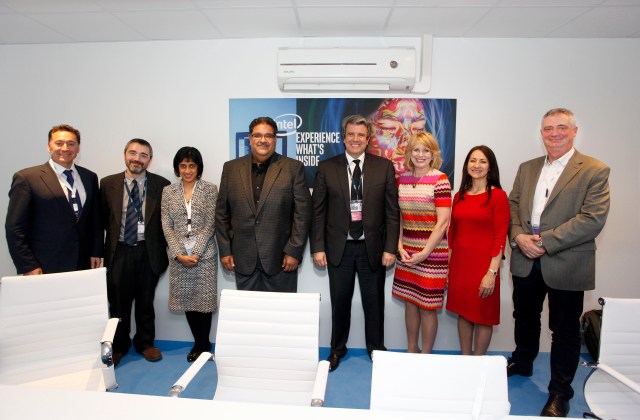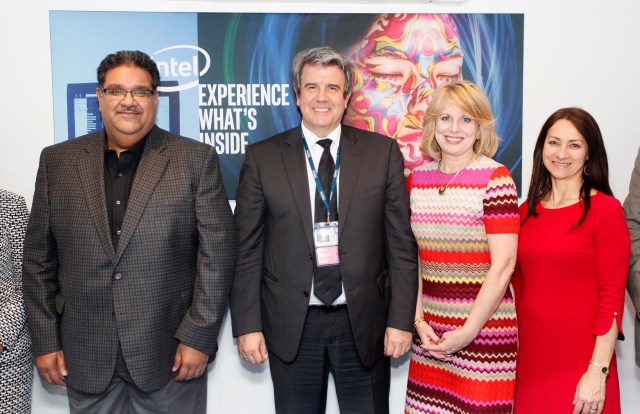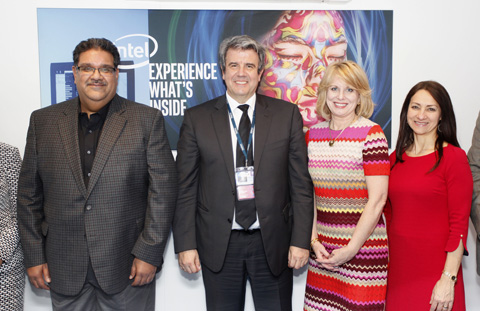- Telefónica will work with Intel to undertake testing activities around pre-standard 5G technologies as well as new features being incorporated in LTE Advanced Pro that may provide useful inputs on the performance and application of future 5G systems.
- Joint evaluation and research tasks will comprise both radio and virtualization workstreams.
Barcelona, February 23rd, 2016.- Telefónica announced it will collaborate with Intel on the next generation of mobile networks known as 5G (5th generation). The two companies will undertake testing activities around pre-standard 5G technologies, using either experimental systems or pre-commercial versions, with enhanced capabilities, of existing systems.
The areas of research and testing proposed cover pre-standard 5G technologies as well as new features being incorporated in LTE Advanced Pro that may provide useful inputs on the performance and application of future 5G systems. However, other different areas of cooperation can be pursued in case it is considered necessary and depending on the development stage of the technologies selected.
Joint evaluation and research tasks will comprise two main areas. Firstly, a workstream dealing with 5G wireless systems focused on millimeter wave Radio Access Technology (RAT), low latency operation, cell-less radio access network, massive/full dimension MIMO, device to device communications and radio technologies for IoT services. On the other hand, a workstream focused on virtualization software for 5G networks.
Testing and research around main Radio issues
5G networks are still in an initial phase of development but the consensus of sector experts estimates that the next mobile generation will considerably improve latency and that the transportation of volumes of data will be 1,000 times greater than now. 5G will allow for the increase of the number of devices simultaneously connected between 10 and 100 times and increase the life span of batteries up to 10 times, among other things. All these requirements will need relevant improvements in technologies and radio systems.
5G will embrace frequencies up to 100 GHz, suitability of frequencies above 6 GHz is under strong research. The objective of the research area of millimeter wave RAT is precisely to carry out testing activities that may help to assess the viability, costs and applications of the use of high frequency bands (> 6 GHz) for the support of the 5G access.
The low latency in 5G is expected to allow for the support of new use cases that may be of interest for both users and operators. The objectives for this area are double: to validate the advantages that low latency may provide for the support of some applications and services (e.g., on line gaming, support to manufacturing processes,…) and to test initial developments expected in LTE Advanced Pro, like 0,5 ms Transmission Time Interval (TTI), when they become available.
The possibility of introducing new Radio Access Network architecture where the user is always connected to the same cell -at least from the user equipment (UE) viewpoint- is considered one of the main novelties for the radio access network architecture. The idea in this case is to test different solutions that provide this kind of architecture, in order to analyze the impact on the mobility support and the capacity, as well as to identify the potential developments that would be required at UE, Radio Access Network (RAN) and transport network levels is order to support it.
Another area that may help to increase the spectral efficiency in 5G systems is the use of higher levels of Multiple-input Multiple-output (MIMO) technologies to support spectral efficiency, either by the use of beamforming techniques or multiuser MIMO. One area of high priority is the he potential extension of these technologies to the FDD spectrum.
Device to Device (D2D) communications will be another area of interest. The objective is to explore the different applications of D2D communications in the context of future 5G systems: D2D communications to extend coverage in a cooperative way, using UEs as relays; D2D communications in critical applications, like inter-vehicular communications; and integration of 3GPP D2D technologies with other standards, like Bluetooth, Wi-Fi Direct.
Finally, the objective regarding radio technologies for IoT services is to test the new capabilities provided by the new LTE technologies defined for IoT services in 3GPP Release 13 (UEs Cat-M1 and Cat-M2), analyzing the impact in terms of volume of data and control plane traffic for different traffic profiles and the impact on the battery life for different traffic profiles.
Virtualization technologies as enablers for 5G
Future 5G Networks will be supported by virtualization technologies, so this agreement will be centered on main topics around that concept: the virtualization of network functions (NFV); software defined networking (SDN); security services, network control and management planes; cloud services and signaling services.
A special focus will be placed on the virtualization of the RAN (Radio Access Network) functionalities. In this respect, Intel and Telefónica will cooperate with other companies in order to foster an ecosystem that allows for extending virtualization benefits to the Radio Access Networks. Current cooperation with companies like Artesyn (whose MaxCore platform is being used for the virtualized infrastructure) and ASOCS Networks (developer of a virtualized base station network functionality) are examples of this expanded ecosystem.
Enrique Blanco, Telefónica Global CTO:
“We are very pleased to have reached this agreement with Intel to cooperate on the next generation of mobile communications technology. 5G has not been defined yet in terms of its technology, solution or architecture and this collaboration will allow us to test 5G wireless systems, virtualization software for 5G networks as well as new features of LTE that may provide useful inputs for building the network of the future.”
Sandra Rivera, vice president and general manager of Intel’s Network Platforms Group:
“Ecosystem collaboration is critical as we lay the foundation for future 5G networks that will deliver exciting new experiences to our lives. Our ongoing collaboration around NFV / SDN lays the foundation for new joint efforts with Telefonica to test 5G client devices and network technologies for mobile and IoT use cases, enabling Telefonica’s network transformation today and into the future”.


From left to right: Murphy Renduchintala, SVP President Client & Internet of Things Intel; Enrique Blanco, Global CTO Telefonica ; Diane Bryant, SVP and General Manager Data Center Group, Intel and Sandra Rivera, vice president and general manager of Intel’s Network Platforms Group









